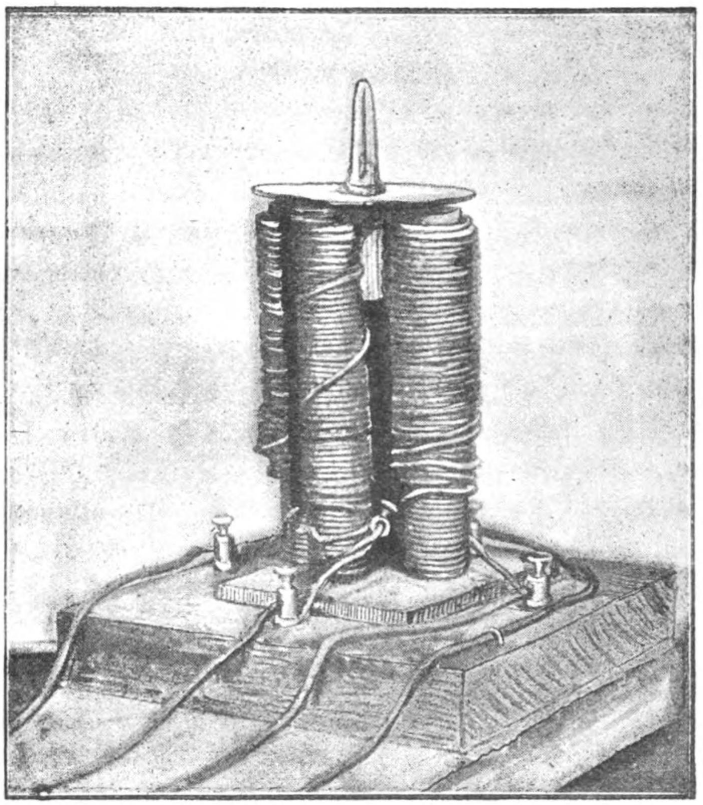Walter Baily's Motor on:
[Wikipedia]
[Google]
[Amazon]
Walter Bailys Polyphase motor (1879) marks the beginning of the development of modern polyphase motors. Mr. Bailey exhibited his invention on the
 Before Baily's invention, the only mode of producing the Arago-rotations of a copper disk had been by rotating beneath it a steel
Before Baily's invention, the only mode of producing the Arago-rotations of a copper disk had been by rotating beneath it a steel 
Proceedings of the Physical Society of London
' Electric motors 18th-century inventors 18th-century inventions
Physical Society of London
The Physical Society of London, England, was a scientific society which was founded in 1874. In 1921, it was renamed the Physical Society, and in 1960 it merged with the Institute of Physics (IOP), the combined organisation eventually adopting the ...
on June 28, 1879, on the occasion of his reading a paper entitled, "A Mode of Producing Arago's Rotations."
Description
 Before Baily's invention, the only mode of producing the Arago-rotations of a copper disk had been by rotating beneath it a steel
Before Baily's invention, the only mode of producing the Arago-rotations of a copper disk had been by rotating beneath it a steel magnet
A magnet is a material or object that produces a magnetic field. This magnetic field is invisible but is responsible for the most notable property of a magnet: a force that pulls on other ferromagnetic materials, such as iron, steel, nickel, ...
. Baily, instead of rotating any material magnet below the disk used a fixed electromagnet
An electromagnet is a type of magnet in which the magnetic field is produced by an electric current. Electromagnets usually consist of wire wound into a coil. A current through the wire creates a magnetic field which is concentrated in the ...
, but caused its magnetism
Magnetism is the class of physical attributes that are mediated by a magnetic field, which refers to the capacity to induce attractive and repulsive phenomena in other entities. Electric currents and the magnetic moments of elementary particles ...
to shift progressively between four successive poles, thus producing in the copper disk pivoted above the eddy-currents, which by their reaction gave the disk a mechanical motion in the direction of the progression of the poles.
The disk in this primitive model is about inches in diameter; the four magnet cores are about 4 inches high, joined to a common yoke; and each is wound with about 150 turns of insulated copper wire 2,5 mm in diameter. The coils are connected two and two in series, like two independent horseshoe magnets set diagonally across one another. The two circuits are brought down separately to an ingenious revolving commutator
In mathematics, the commutator gives an indication of the extent to which a certain binary operation fails to be commutative. There are different definitions used in group theory and ring theory.
Group theory
The commutator of two elements, a ...
built up of a simple arrangement of springs and contact strips mounted on a bit of wood, with a wire handle by which it is turned. On rotating it, the currents from two batteries are caused to be reversed alternately in the two circuits, giving rise to the following successions of polarity in the four poles and so forth.
Baily's view on rotating magnetic field
Mr. Baily had very clear views as to how far this really represented a rotatory magnetic field. His own words are as follows:"The rotation of the disk is due to that of the magnetic field in which it is suspended; and we should expect that if a similar motion of the field could be produced by any other means the result would be a similar motion of the disk." "Possibly the rotation of the magnet may be the only practicable way of producing a uniform rotation of the field; but it will be shown in this paper that the disk can be made to rotate by an intermittent rotation of the field effected by means of electromagnets."The author then goes on to discuss the result of the increase in strength of a pole while a neighboring pole of the same sign decreases in strength, and suggests that if a whole circle of poles were arranged under the disk, and successively excited in opposite pairs, the series of impulses all tend to make the disk move in one direction around the axis; adding:
"In one extreme case, viz. when the number of electromagnets is infinite, we have the case of a ''uniform'' rotation of the magnetic field, such as we obtain by rotating permanent magnets."He then returns to the case of his actual model with two pairs of poles ''a a'
See also
*Arago's Rotations Arago's rotations is an observable magnetic phenomenon that involves the interactions between a magnetized needle and a moving metal disk. The effect was discovered by François Arago in 1824. At the time of their discovery, Arago's rotations were s ...
* Timeline of the Electric Motor Electric motors have a long history going back to the early nineteenth century.
Nineteenth century
Twentieth century
References
{{electric motor
Electric motors ...
* Rotating magnetic Field A rotating magnetic field is the resultant magnetic field produced by a system of coils symmetrically placed and supplied with polyphase currents. A rotating magnetic field can be produced by a poly-phase (two or more phases) current or by a singl ...
* Induction Motor
An induction motor or asynchronous motor is an AC electric motor in which the electric current in the rotor needed to produce torque is obtained by electromagnetic induction from the magnetic field of the stator winding. An induction mot ...
References
External links
*Proceedings of the Physical Society of London
' Electric motors 18th-century inventors 18th-century inventions